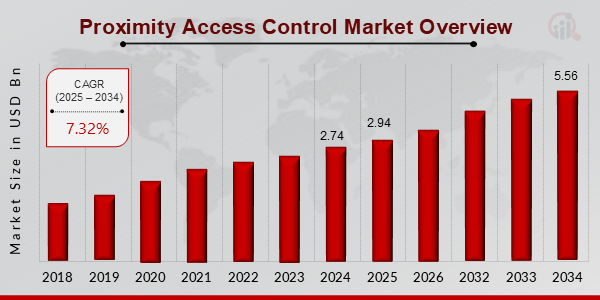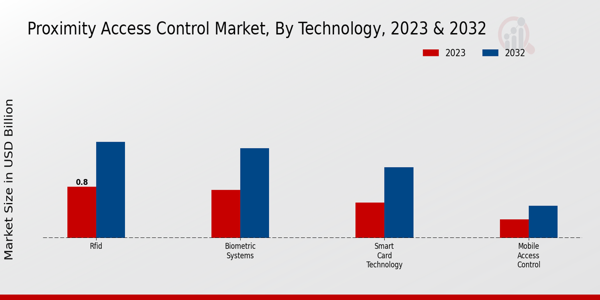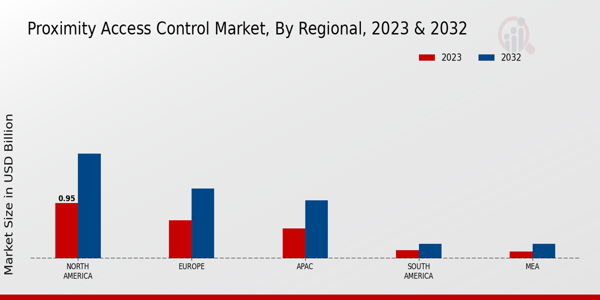Proximity Access Control Market Overview
Proximity Access Control Market is projected to grow from USD 2.94 Billion in 2025 to USD 5.56 Billion by 2034, exhibiting a compound annual growth rate (CAGR) of 7.32% during the forecast period (2025 - 2034). Additionally, the market size for Proximity Access Control Market was valued at USD 2.74 billion in 2024.
Key Proximity Access Control Market Trends Highlighted
Proximity Access Control MarketIncreasing concerns over security and the need for efficient access management are driving the Proximity Access Control Market. As organizations aim to protect their assets, the demand for advanced access control systems continues to rise. The growth of smart buildings and the Internet of Things (IoT) also play a pivotal role, as these technologies enhance the overall effectiveness of access control solutions. Additionally, government regulations and standards promoting secure environments further boost the market's growth. There are numerous opportunities for growth in this market. The integration of cloud-based solutions is becoming increasingly attractive as businesses seek flexible and scalable systems.
Moreover, advancements in biometric technology present new avenues for enhancing security and user convenience. This creates a landscape ripe for innovation, where companies can develop solutions that meet the evolving needs of users and organizations. The rising adoption of mobile access control solutions also offers significant potential, particularly among younger, tech-savvy users who prefer seamless and convenient entry methods. Recent trends indicate a shift towards more user-friendly access control systems that simplify management while maintaining robust security. The use of mobile applications for proximity access control has gained momentum, allowing users to manage access with ease.
Furthermore, there is a growing emphasis on sustainability, with companies looking for eco-friendly solutions in their access control systems. Manufacturers are increasingly focusing on providing integrated solutions that combine various security features in a single platform. The move towards data-driven access control mechanisms is also observed as organizations strive to leverage data analytics for improved decision-making and enhanced security measures. Overall, the market is evolving rapidly, driven by technological advancements and changing consumer preferences.
Figure 1 Proximity Access Control Market Overview (2025-2034)

Source: Primary Research, Secondary Research, MRFR Database and Analyst Review
Proximity Access Control Market Drivers
Increasing Security Concerns and Adoption of Advanced Technology
The increasing incidence of security breaches and unauthorized access has driven the demand for more robust access control solutions, making security a top priority across various sectors. Organizations today recognize the significance of safeguarding their assets, employees, and confidential information. This awareness has contributed to the growth of the Proximity Access Control Market Industry, as businesses are keen to invest in technologies that enhance their security measures.
The integration of advanced technologies, including biometric systems, cloud-based access control systems, and smart cards, in proximity access control solutions, has made them more efficient and user-friendly. Moreover, the perception of proximity access control systems as a standard requirement rather than an optional investment encourages widespread adoption. This trend is particularly strong in sectors such as healthcare, banking, education, and government, where managing access to sensitive areas is crucial.
As technological advancements provide better functionalities and capabilities, organizations are more inclined to upgrade their access control systems, ultimately pushing the market toward expansive growth. Overall, the quest for higher security measures and the incorporation of technological innovations are expected to significantly elevate the size and development of the Proximity Access Control Market in the future.
Growing Demand for Contactless Solutions
The recent surge in demand for contactless access solutions, accelerated by the global pandemic, has positively influenced the Proximity Access Control Market Industry. With a heightened focus on hygiene and safety, organizations are increasingly adopting systems that minimize physical contact. Proximity access control solutions provide an effective way to achieve this, as they allow users to gain access without touching physical surfaces. This trend is gradually reshaping how companies and institutions approach security measures.
Expansion of Smart Infrastructure and IoT Integration
The ongoing development of smart buildings and infrastructure, combined with the increasing integration of Internet of Things (IoT) technology, significantly propels the Proximity Access Control Market Industry. As urbanization continues and the quest for efficient building management systems rises, the need for intelligent access control solutions has become paramount. By embedding access control systems within smart city frameworks, privacy and security can be managed more effectively.
The IoT offers real-time monitoring and analytics, improving decision-making around access management. Consequently, the expanded adoption of smart infrastructure enhances the demand for proximity access control systems that can seamlessly integrate with various other building technologies.
Proximity Access Control Market Segment Insights
Proximity Access Control Market Technology Insights
The Proximity Access Control Market, within the Technology segment, shows a robust growth trajectory, highlighted by a market value of 2.39 USD Billion in 2023 and projected to reach 4.5 USD Billion by 2032. This segment includes various technologies that enhance security and streamline access, resulting in increased demand across diverse industries.
Among these technologies, RFID holds a major role, with a market value of 0.8 USD Billion in 2023, expected to grow to 1.5 USD Billion by 2032, indicating its dominant position driven by the rising need for efficient asset management and tracking.
Biometric Systems, another significant player, was valued at 0.75 USD Billion in 2023, with projections of reaching 1.4 USD Billion by 2032. This technology is crucial as it leverages unique physical characteristics for secure access, thereby gaining popularity in high-security sectors.
Smart Card Technology, valued at 0.55 USD Billion in 2023 and anticipated to reach 1.1 USD Billion in 2032, serves as an important access control method, particularly in corporate and governmental applications, where data security is paramount. Similarly, Mobile Access Control, though comparatively lower in valuation at 0.29 USD Billion in 2023, is expected to rise to 0.5 USD Billion by 2032.
This technology is becoming more significant as smartphones increasingly replace traditional access methods, reflecting the ongoing trend toward digitalization. These technologies not only bolster security but also improve user convenience and operational efficiency, driving substantial market growth and highlighting the importance of each segment's contribution to the overall landscape of the Proximity Access Control Market. As industries move towards smarter and more secure access solutions, the market continues to evolve, supported by innovation and an expanding array of applications.
Figure 2 Proximity Access Control Market By Technology (2023-2032)

Source: Primary Research, Secondary Research, MRFR Database and Analyst Review
Proximity Access Control Market Component Insights
The Component segment of the Proximity Access Control Market plays a crucial role in shaping the industry landscape, with a market valuation of 2.39 USD Billion in 2023. This segment encompasses various elements, including Readers, Credentials, Controllers, and Software, each contributing distinctively to the functionality and efficiency of proximity access systems. Readers dominate the market, as they serve as the primary interface for users, facilitating seamless entry and verification processes. Credentials are equally significant, providing the essential data needed for secure access.
Controllers are vital for managing system operations and ensuring effective communication between components. Software is increasingly becoming important as it allows for advanced features such as data analytics and system integration. The continuous advancement in technology drives innovation in these components, further propelling market growth. Additionally, the demand for robust security measures in various sectors, including government, healthcare, and corporate environments, enhances the need for sophisticated proximity access control solutions. Overall, the Proximity Access Control Market data suggests an ongoing shift towards integrated and smarter systems, presenting numerous opportunities for stakeholders in the industry.
Proximity Access Control Market End-Use Insights
The Proximity Access Control Marketdemonstrates a growing interest across various end-use sectors, including Commercial, Residential, Industrial, and Government. The Commercial segment plays a vital role as businesses increasingly adopt advanced security measures, driving the demand for proximity access control solutions. Similarly, the Residential segment is experiencing a rise in smart home technology integration as homeowners seek enhanced security and convenience.
The Industrial sector also commands attention, maintaining rigorous security protocols to protect sensitive information and assets. Furthermore, the Government segment's focus on national security and efficient access management systems contributes extensively to the industry's growth. Collectively, these sectors illustrate a robust demand landscape fueled by trends such as digital transformation and rising security awareness, thereby solidifying the Proximity Access Control MarketMarket's position in the evolving security landscape. Enhanced technology and the need for seamless access control are pivotal growth drivers, which present new opportunities despite challenges like market fragmentation and integration costs. Overall, the comprehensive analysis of the market growth indicates a promising trajectory, with significant contributions anticipated from these key sectors.
Proximity Access Control Market Deployment Type Insights
The Proximity Access Control Market is experiencing steady growth, particularly in the Deployment Type segment, which includes On-Premises and Cloud-Based solutions. In 2023, the market was valued at 2.39 billion USD, with a significant rise expected as businesses increasingly prioritize secure access solutions. Cloud-based systems are gaining traction due to their flexibility and scalability, allowing organizations to adapt quickly to changing demands. On-premises deployments, however, still dominate as they offer greater control and customization for sensitive environments.
The market is witnessing trends such as increased integration of AI and IoT technologies, enhancing the accuracy and efficiency of access control systems. Additionally, factors like the growing need for security in both commercial and residential sectors, alongside the rising awareness of data privacy, are driving this market forward. Meanwhile, challenges such as initial installation costs and ongoing maintenance for On-Premises systems persist. The Proximity Access Control Market statistics highlight a growing demand for integrated solutions, showcasing the opportunities for innovation and development within both Deployment Types.
Proximity Access Control Market Regional Insights
The Regional aspect of the Proximity Access Control Market reveals a dynamic landscape with diverse growth opportunities. In 2023, the market is valued at 2.39 USD Billion, with significant contributions from various regions.
North America holds a majority share, valued at 0.95 USD Billion, anticipated to grow to 1.8 USD Billion by 2032, driven by technological advancements and increasing security concerns. Europe follows, with a market value of 0.66 USD Billion in 2023, projected to be 1.2 USD Billion in 2032, influenced by stringent regulations and heightened focus on cybersecurity.
The APAC region, valued at 0.52 USD Billion in 2023, is expected to reach 1.0 USD Billion in 2032, showcasing a robust growth trajectory attributed to rapid urbanization and infrastructure development. South America and MEA are smaller yet significant contributors, valued at 0.14 USD Billion and 0.12 USD Billion in 2023, respectively, with projections of 0.25 USD Billion by 2032. The growth in these regions is propelled by increasing investments in security systems and the rising adoption of smart technologies.
Overall, the Proximity Access Control Market segmentation highlights varying degrees of influence and growth potential across regions, underlining opportunities for stakeholders in emerging markets.
Figure 3 Proximity Access Control Market By Regional (2023-2032)

Source: Primary Research, Secondary Research, MRFR Database and Analyst Review
Proximity Access Control Market Key Players and Competitive Insights:
The Proximity Access Control Market has witnessed significant growth due to increasing security concerns and the need for enhanced access control measures across various sectors. As technology advances, the adoption of proximity access control systems has become essential for organizations aiming to safeguard their assets. The competitive landscape of this market is marked by a diverse range of players, including established manufacturers and emerging companies that are continuously innovating to capture market share. Factors such as technological advancements, integration capabilities with existing security systems, and the growing trend of smart buildings contribute to the competitive dynamics. As organizations increasingly prioritize security, the market is also seeing a rise in demand for flexible, scalable, and user-friendly access control systems, shaping the strategies of key players.
Dahua Technology has established itself as a prominent player in the Proximity Access Control Market, leveraging its strengths in innovative product developments and a strong commitment to quality. The company offers a wide range of access control solutions that cater to various industries, integrating advanced technology with ease of use. Dahua Technology focuses on ensuring its products are equipped with features such as biometric authentication and cloud connectivity, which enhance security and streamline operations. Its robust research and development capabilities enable Dahua Technology to remain at the forefront of technology trends, allowing the company to attract new clients while maintaining satisfaction among existing users continuously. With a strong emphasis on customer service and support, Dahua Technology has built a solid reputation, contributing to its sustained presence in this competitive market.
IDEMIA is another influential entity in the Proximity Access Control Market, known for its expertise in identity and security solutions. The company excels in providing comprehensive access control systems that incorporate cutting-edge technologies such as biometrics and mobile credentials. IDEMIA's commitment to innovation, coupled with its strategic partnerships, enhances its ability to meet varied market demands. With a focus on providing secure, reliable, and efficient access control solutions, IDEMIA has successfully positioned itself as a trusted provider for organizations looking to enhance their security infrastructure. The company's ability to customize solutions to meet client needs has further solidified IDEMIA's standing in the market, allowing it to thrive amidst increasing competition. Its continuous investment in research and development ensures that IDEMIA remains at the leading edge of technological advancements in proximity access control, enhancing its overall market presence.
Key Companies in the Proximity Access Control Market Include
- Dahua Technology
- IDEMIA
- Honeywell
- Tyco Integrated Security
- Magnetek
- Bosch Security Systems
- ZKTeco
- RFIDeas
- Siemens
- Allegion
- Johnson Controls
- HID Global
- G4S
- Assa Abloy
- Nedap
Proximity Access Control Market Industry Developments
The Proximity Access Control Market is witnessing significant developments, with major players like Dahua Technology, IDEMIA, and Honeywell expanding their technological offerings to enhance security and user experience. Recent advancements include the integration of biometrics and mobile technology into access control systems, catering to the growing demand for contactless solutions in light of the ongoing global health concerns. Mergers and acquisitions are shaping the market landscape, with key firms like Assa Abloy actively pursuing strategic partnerships to broaden their product portfolios and market reach. Concurrently, ZKTeco and RFIDeas are also focusing on innovation and collaboration to solidify their positions and enhance operational efficiency.
Current affairs indicate a robust growth trajectory in market valuation, driven by increased investments in security infrastructure across various sectors, including commercial, governmental, and residential. Companies such as Bosch Security Systems and Siemens are leveraging advancements in artificial intelligence and IoT capabilities to provide more sophisticated access control solutions, responding to the evolving security challenges faced by organizations today. This competitive environment is pushing for continuous improvements and greater emphasis on integrated security solutions in the proximity access control realm.
Proximity Access Control Market Segmentation Insights
- Proximity Access Control Market Technology Outlook
- RFID
- Biometric Systems
- Smart Card Technology
- Mobile Access Control
- Proximity Access Control Market Component Outlook
- Readers
- Credentials
- Controllers
- Software
- Proximity Access Control Market End-Use Outlook
- Commercial
- Residential
- Industrial
- Government
- Proximity Access Control Market Deployment Type Outlook
- On-Premises
- Cloud-Based
- Proximity Access Control Market Regional Outlook
- North America
- Europe
- South America
- Asia-Pacific
- Middle East and Africa
Proximity Access Control Market Report Scope
|
Report Attribute/Metric
|
Details
|
|
Market Size 2024
|
2.74 (USD Billion)
|
|
Market Size 2025
|
2.94 (USD Billion)
|
|
Market Size 2034
|
5.56 (USD Billion)
|
|
Compound Annual Growth Rate (CAGR)
|
7.32% (2025 - 2034)
|
|
Report Coverage
|
Revenue Forecast, Competitive Landscape, Growth Factors, and Trends
|
|
Base Year
|
2024
|
|
Market Forecast Period
|
2025 - 2034
|
|
Historical Data
|
2019 - 2023
|
|
Market Forecast Units
|
USD Billion
|
|
Key Companies Profiled
|
Dahua Technology, IDEMIA, Honeywell, Tyco Integrated Security, Magnetek, Bosch Security Systems, ZKTeco, RFIDeas, Siemens, Allegion, Johnson Controls, HID Global, G4S, Assa Abloy, Nedap
|
|
Segments Covered
|
Technology, Component, End Use, Deployment Type, Regional
|
|
Key Market Opportunities
|
Increasing demand for contactless technologies, Expansion in smart city initiatives, Growth in IoT integration, Rising cybersecurity concerns, Advancements in biometric technology
|
|
Key Market Dynamics
|
Growing demand for security solutions, Rising adoption of contactless technology, Increasing need for regulatory compliance, Expansion of smart building initiatives, Advancements in biometric integration
|
|
Countries Covered
|
North America, Europe, APAC, South America, MEA
|
Frequently Asked Questions (FAQ) :
The Proximity Access Control Market is expected to be valued at 5.56 USD Billion in 2034.
The expected CAGR for the Proximity Access Control Market is 7.32% from 2025 to 2034.
North America is projected to have the largest market share with an expected value of 1.8 USD Billion in 2032.
The RFID segment is expected to reach a market size of 1.5 USD Billion by 2032.
Key players in the market include Dahua Technology, IDEMIA, Honeywell, and HID Global, among others.
The Biometric Systems segment is estimated to be valued at 1.4 USD Billion by 2032.
The APAC region is anticipated to grow to a market size of 1.0 USD Billion by 2032.
Mobile Access Control is projected to have a market size of 0.5 USD Billion by 2032.
Key drivers include increasing security concerns and technological advancements in access control systems.
South America is expected to grow to a market value of 0.25 USD Billion by 2032.

















